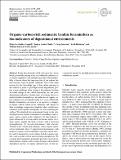Organic carbon rich sediments : benthic foraminifera as bio-indicators of depositional environments
Abstract
Fjords have been described as hotspots for carbon burial, potentially playing a key role within the carbon cycle as climate regulators over multiple timescales. Nevertheless, little is known about the long-term fate of the carbon that may become stored in fjordic sediments. One of the main reasons for this knowledge gap is that carbon arriving on the seafloor is prone to post-depositional degradation, posing a great challenge when trying to discriminate between an actual change in the carbon deposition rate and post-depositional carbon loss. In this study, we evaluate the use of modern benthic foraminifera as bio-indicators of organic carbon content in six voes (fjords) on the west coast of Shetland. Benthic foraminifera are known to be sensitive to changes in organic carbon content in the sediments, and changes in their assemblage composition therefore reflect synchronous variations in the quantity and quality of carbon reaching the seafloor. We identified four environments based on the relationship between benthic foraminiferal assemblages and organic carbon content in the sediments: (1) land-locked regions influenced by riverine and/or freshwater inputs of organic matter, namely the head of fjords with a restricted geomorphology; (2) stressed environments with a heavily stratified water column and sediments rich in organic matter of low nutritional value; (3) depositional environments with moderate organic content and mild or episodic current activity; and (4) marginal to coastal settings with low organic content, such as fjords with an unrestricted geomorphology. We conclude that foraminifera potentially provide a tool to disentangle primary organic carbon signals from post-depositional degradation and loss of organic carbon because of their environmental sensitivity and high preservation potential in the sedimentary record.
Citation
Lo Giudice Cappelli , E , Clarke , J , Smeaton , C , Davidson , K & Austin , W E N 2019 , ' Organic carbon rich sediments : benthic foraminifera as bio-indicators of depositional environments ' , Biogeosciences , vol. 16 , pp. 4183-4199 . https://doi.org/10.5194/bg-16-4183-2019
Publication
Biogeosciences
Status
Peer reviewed
ISSN
1726-4170Type
Journal article
Description
Funding: BBSRC/NERC (ref. BB/M026620/01). Isotope analysis was supported by NERC Life Science Mass Spectrometry Facility (CEH_L_098_11_2015).Collections
Items in the St Andrews Research Repository are protected by copyright, with all rights reserved, unless otherwise indicated.

